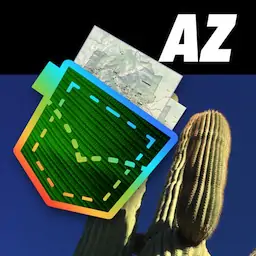"Scenics - Old Highway 180 and Petrified Wood" by U.S. National Park Service , public domain
Route 66 - America's MainstreetPetrified Forest |
Brochure Route 66 - America's Mainstreet at Petrified Forest National Park (NP) in Arizona. Published by the National Park Service (NPS).
featured in
| National Parks Pocket Maps |  | |
| Arizona Pocket Maps |  |
Petrified Forest
National Park Service
U.S. Department of the Interior
Petrified Forest National Park
Arizona
Route 66
America’s Mainstreet
It winds from Chicago to L.A.,
More than two thousand miles all the way.
Get your kicks on Route Sixty-six!
Bobby Troup, 1946
Echoes of the Past
Near the rim of the Painted Desert, you stand
on old Route 66. The line of the roadbed
and the telephone poles in front of you
mark the path of the famous “Main Street of
America” as it passed through Petrified Forest
National Park. From Chicago to Los Angeles,
this heavily traveled highway was not only
a road. It stood as a symbol of opportunity,
adventure, and discovery.
A trip from Middle America to the Coast
could take about a week—no Interstate
speeds here! For many, the journey was not
just across miles, it was across cultures and
lifestyles—from the most mundane to the
exotic. Of course getting to your destination
was important, but the trip itself was a
reward. From the neon signs of one-of-a-kind
motels to burgers and chicken fried steaks
served in the multitudes of restaurants, from
the filling stations that served as miniature
oases to gaudy tourist traps, these more than
2,200 miles of open road were magical.
Today, the road is merely a whisper through the
grassland of Petrified Forest, the only national
park site with a segment of the Mother Road
within its boundaries. Gaze down the long road
and listen. You may hear echoes of the past—
echoes of Route 66.
The Mother Road
Considered by many as the Mother of
Transcontinental Highways, Route 66 is a
quintessential representative of 20th century
American history and culture. Commissioned
in 1926, the road was unique among other
highways with a catchy tune that was ideal for
promotion efforts, and with a unique arcing
path across the country. Renowned as the
shortest all-weather route connecting the
industrial Midwest to the rural southwest, it
helped facilitate the unprecedented transfer of
ideas, goods, and people across the country.
Traveling through Illinois, Missouri, Kansas,
Oklahoma, Texas, New Mexico, Arizona, and
California, it also served as a major corridor
for migrating dust bowlers in the 1930s; for
important WWII military functions in the
1940s; and for thousands of families in the
1950s during the emergence of “vacation
culture.” Roadside architecture and businesses
flourished, changing forever the history and
character, and lives of the towns through which
the route passed. As well, the arts played a
critical role in immortalizing the road through
literature, song, and film, which served to
elevate the road to a phenomenal, pop-culture
status which persists to this day.
Rediscovering Route 66
A trace of the original alignment of Route 66
can be discovered during your visit to Petrified
Forest National Park. Entering the park from
the northern entrance, the first indication is
a dirt road just before Tiponi Point. The old
sign for the park that once graced Route 66 is
nothing but rubble today and most of the road
side attractions such as Lions Farm and The
Painted Desert Park—with its vista-seeking
tower to climb—are just memories.
Visitors to the park will discover a jewel just
off the main stretch of the Mother Road,
the Painted Desert Inn, the park’s National
Historic Landmark. Originally built by business
man Herbert Lore, the Painted Desert Inn
reflects the Pueblo Revival style of National
Park architect Lyle Bennett and the designs
of renowned Mary Colter of the Fred Harvey
Ironically, it was the popularity of automobile
travel that ultimately led to the highways
demise through the construction of limitedaccess interstates in the 1970s. With the slow,
incremental opening of the interstates, travel
gradually shifted away from the towns and main
streets of Route 66 passed, until the highway
was officially decommissioned in 1985.
However, the public demanded that the road
and its history be kept alive, and preservation
and tourism movements have since flourished.
Almost 90 years since its birth, and nearly 30
years since its decommissioning, Route 66
remains one of the most revered, beloved, and
sought out historic roads in the world.
Company. The warm pinkish brown walls
protect murals painted in the late 1940s by
Hopi artist Fred Kabotie in what were once the
Dining Room and Lunch Room that catered to
travelers. The Painted Desert Inn was an oasis
along the dusty stretch of Route 66.
Continuing around the arch of the park road,
featuring the spectacular views of the colorful
Painted Desert, visitors discover a pullout that
overlooks the alignment of Route 66, following
the trace through grasses and sagebrush to the
Interstate that replaced the old highway. The
rusted remains of an old vehicle remind us of
the heyday of America’s Main Street and the
romance of the road.
Remember that archeological and historic sites are fragile. Every little artifact tells part of the story. Leave these fascinating
sites for future generations to enjoy and explore. They are part of our American legacy.
www.nps.gov/pefo
EXPERIENCE YOUR AMERICA
April 2013


